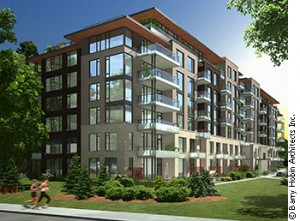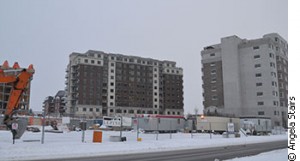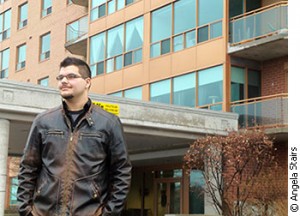Tags
Related Posts
Share This
New heights of suburban life
In recent years, the skyline of the Ottawa suburbs has seen additions with the development of high-rise apartment complexes and condos. The city has goals for more intensification, causing development in the city to expand vertically instead of horizontally. This trend is challenging the traditional notion of going to the suburbs to settle down with a big house and a white picket fence.

An architect’s rendering of Two the Parkway shows a hopeful melding of urban and suburban, slated for completion in 2016.
In 2012, there were 2,769 apartment-style units starting to be built in Ottawa, compared to 1,592 single-detached houses. Of those apartment-style start-ups, 2,277 were condos and only 452 were rental units. This trend towards more apartment-style residential development has affected not only the downtown core, but also the surrounding suburban areas. Kanata, for instance, has the Kanata Lakes Apartments project, currently under construction in the town centre, and the condo Two the Parkway, slated for completion in Beaverbrook in 2016.
Some observers have questioned this trend towards more high-rise suburban development. With the condo boom in the downtown core over past years, the high-rise trend has become commonplace, but given the unusual nature of this type of development in the suburbs, some question the sustainability of these developments.
City strategy: Build up, not out
The program manager for Ottawa’s planning and growth management, David Wise, says the increased vertical development in the suburbs is due in part to city strategies towards intensification and increasing the population densities of residential areas. Wise says that population densities are an important factor in community planning and strategic development. If you want to have adequate community centres and schools, you have to make sure there are enough people locally to support those institutions. There is also the cost of the supporting infrastructure, like sewers and underground piping, which is very expensive and adds up when looking to increase residential development horizontally. The older Kanata and Beaverbrook areas were originally developed with 15 to 20 housing units per hectare, but the city’s plan says new developments are to be built with 34 units per hectare. The city is also trying to keep all new development within the designated urban limits, which includes some of the suburbs. “We want to make sure we’re getting as much usage as we possibly can out of those things and really maxing it up; otherwise your taxes are just going to go through the roof,” Wise says.
The new trend targets “seniors in the 55-to-60 range who want to stay in the suburbs.” — Ottawa real estate agent Patricia Chiarelli
Another issue to consider with this upward development is the coming light rail transit system (LRT) and transportation plans for the city, which in parts of Kanata will mean increased “transitways” and “busways”. Christine Chollette, an urban planner with Lloyd Phillips and Associates, an Ottawa planning consulting firm, says there is currently a whole movement towards transit-oriented development in Ottawa, which leads to more high-rise development. In areas designated to become hubs for transit, new developments being approved (through by-law amendments) that have greater heights and densities than those outlined in the city’s official plan. In Kanata, the city supports development up to nine stories in certain areas, mainly on main streets, but this height limit can be raised in some areas deemed fit, like those where transit hubs are expected in the future.

Even in dead of winter, no end to construction. This Kanata Lakes project is just one of the apartment complexes in Kanata town centre.
However, it is important to note that most intensification in the suburbs of Ottawa is happening in the suburban town centres, as not all regions have the infrastructure to support such development. Gary Sealey, President of the KBCA (Kanata Beaverbrook Community Association) says, “The infrastructure capable of absorbing much intensification is not the existing residential areas; it’s in the town centre. There have been recent floods in the residential areas partly because the infrastructure has not been built systematically, for the increased use.”
Seniors on the rise in the suburbs?
According to sources, the general consensus is that the demand for suburban condos and high-rises will catch up to the current over-supply. Anne-Marie Shaker, CMHC (Canadian Mortgage and Housing Corporation) market analyst for Ottawa, says this sort of give and take with the market is normal. “The housing market re-balances. We are higher than population now, but it goes through cycles, ” she says. The CHMC rental-market report for Ottawa states that 23 percent of condos are now being bought as investment properties for resale or rent later. In the downtown core, the main market for these condos is twofold: young professionals and empty nesters — both attracted to convenient urban living. However, while young professionals generally prefer to live downtown, Ottawa real estate agent Patricia Chiarelli says that sometimes these clients will settle for suburban condos because of the lower price point.
The empty-nester population is another rapidly growing market and especially marketable in the suburbs, Chiarelli says. “They’re usually seniors in the 55-to-60 range who want to stay in the suburbs, usually where their families are living, and they’ve been living in the same area as well.”
Ken Hoppner of Morley Hoppner Group, the developers behind Two the Parkway, had this trend in mind, marketing this development to older residents looking to downsize. With the city’s projection that 20 percent of Ottawa’s population by 2031 will be seniors, there is a substantial market there. Hoppner says that this age group’s people have owned their homes for practically all their lives, and they still want to buy, as opposed to downsizing to a rental or a retirement home. Ottawa Citizen columnist and writer David Reevely agrees that it is reasonable to say that people of this age group would want to stay in the suburbs and continue to buy, since owning a home is the cultural norm for their generation: “They’re not all downtowners at heart who were forced to the suburbs so they could have a lawn where their kids could play but now want to scoot back to Centretown as soon as they’re able. They actually like where they chose to live.”
Vertical Kanata
Sealey says the trend towards suburban high-rises can’t be designated simply as a positive or a negative, as it is not a black-and-white issue. Of city hall’s initiative toward a more pedestrian-friendly Ottawa, Sealey says, “What I think is likely to be consequential is the bringing back of some corner stores, local diners, local small services to residential areas.” On this track, these new city strategies could be credited with trying to create more convenient and dynamic communities in Ottawa outside the urban core.
But there is still some public skepticism as to whether there will soon be demand for all of this increased vertical space in Kanata. This is to be expected, says Reevely, because these developments are so unusual compared to what development in Ottawa’s suburbs has historically looked like.

Movin’ on up. Kevin Starkgraff and family recently downsized to this apartment building at Kanata’s Park Ridge Place.
The CMHC Housing Market Outlook Report for Ottawa states that factors like the unstable economy and job market, little resale demand, and the increasing aging population all point to more demand for condominiums and apartments in the future, with semi-detached homes and row houses beating out single-detached homes as the new “dominant low-rise dwelling type” for the first time in 15 years. This trend has embraced the suburbs, too. Says Hoppner, “It’s different from the downtown area where there’s all kinds of opportunities for someone to buy a condo. In Kanata there’s very few.”
Chollette says this housing trend and current city development strategies speak to general lifestyle changes as well, with people living in smaller units, with more city conveniences closer to home. This then creates less need for a car, and makes the suburbs more of a self-sufficient town instead of a bedroom ring around the city.
Kanata resident Kevin Starkgraff, 21, just downsized from a single-detached home to an apartment complex in the Kanata town centre with his family. He says he enjoys being closer to all the conveniences increasingly located in the suburban town. “We prefer the apartment style of living, and we like the convenience of the location,” he says.
Home-page photo © Flickr beyondhue.





